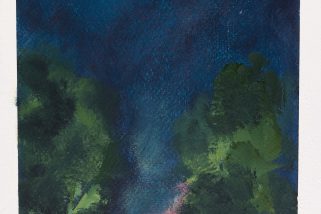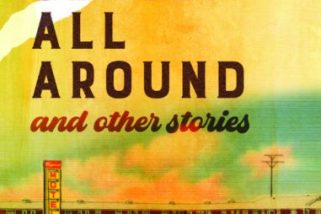
“La Guapa” by Marianela Medrano
No one has ever seen a Ciguapa, but Grandma and Grandpa told me the story so many times that it became reality. Tia Ceci, Mami and Papi, told it to me so many times that it got recorded in my cells the way important things are recorded. If you don’t believe me, ask Nelly. She also heard the same story. The two of us listened as if there was nothing else to do in the world but to sit down and listen.
Nelly and I have seen the Ciguapa. The first time, we were playing under the thatch eaves of our house, gathering goat droppings to make a stew. We collected the animal pellets for cooking in the clay pots we made with Mami. We walked around bent with a cupped hand and the other picking up the droppings as if they were treasures. At that time Mattel did not exist in our world, nor had the furor of plastic touched us. We made believe that the pellets were beans that we cooked together with the white flowers of Yerba Amarga we used as rice. That was before Mami let us use the colorful seeds of the annatto and the morsels clinging to the pot after the rice was cleaned for the main meal. She was standing there looking at us with a smile on her face.
The girl with feet pointing backwards and long hair covering her naked body stared at us with eyes so black they seemed bottomless. Her feet left footprints into which Nelly and I stepped with ours. Since that day, every evening we would go in pursuit of Ciguapa’s tracks. It was a time when we were amused by everything—unlike now when we are so different and we don’t know what to say to each other anymore. Now that Miami’s heat and New England’s cold separate us, we hardly recognize each other.
The Ciguapa, moody and sullen, could turn anyone who looked into her eyes into stone, except Nelly and me. La Guapa looked at us with sad eyes and instead of turning us into stone she made us more human. We used to leave the two-pane window open to cool down the room after it was baked in the sun all day. She began to appear in our window. That’s how we lost the fear of the night and the spirits of the dead we imagined lurking in the shadows.
In the darkness Nelly and I used to look through the open window, looking for lights or spirits of dead jupías, which according to Mami cross the dark edge of the night. Every time a light appeared we used to shout together, “Who’s there? Show your navel right now!” We knew that if it was the spirit of the dead it would run because they have no navels. At least that’s what Mami told us. We knew that the Ciguapa was not dead because she parted her long hair covering her naked body and showed us her navel. Nelly and I would stare in shock and then go back to sleep saying the beads of the rosary in our hands to ward off evil spirits and keep bringing la Ciguapa back.
Nelly and I realized that Seño Laura was a Ciguapa long before what happened happened. Seño Laura’s eyes changed forever after her husband ran away with a young girl from El Cayal. La Seño Laura was skinny and taught us to write letters in perfect form, but sometimes in the middle of class her eyes would travel far, become sad and empty; I looked at her and I too would be sad. Later I told Nelly about her and she too began to get sad when she looked at La Seño’s eyes.
La Seño Laura turned into a Ciguapa way before the girl from El Cayal. The first time her eyes took on that power which turned everyone into stone, except Nelly and me, was after her husband fooled around with Fefa, the bachatera who sang in the club at the end of the evening. Fefa was tall and wore colored wigs and perfumes that enchanted men. Fefa played the accordion as a goddess and inflamed the audience with her perico ripiao about betrayal and pleasure. I have forgotten the lyrics of her songs, but I do remember very well the musty smell of bats in the club where we did the veladas. I loved to hide behind the curtain to see Fefa shine on stage lit by kerosene lamps.
My sisters got the shows ready at the club. Nelly always played the role of the weeping woman in the dramas. In one of them she played the wounded woman who recited a list of names of others with whom her boyfriend had betrayed her. In the end, Nelly fell to the floorboards and died of grief by saying the name of Petra, “the most evil of all,” as the last line called for. The curtain came down and Nelly would come back to life. It was the last show we did before we moved to the city, when Nelly wrote the drama about the names of women. She wrote it right before she learned to look at the sadness in the eyes of La Seño.
La Seño Laura used to strip in the middle of class causing a commotion and we would gather around her to give her cover. Her eyes became sadder and darker. La Seño had long black hair, the blackest in the village. She looked like an Indian, with soft skin, the color of honey. The second time she had a fit and suffered a patatú, she was suspended from school, before we even learned to write properly.
After that we got used to the heckling voices on the road following the thin body of Seño, covered only by her jet black hair, not as bright as before, because after the girl from el Cayal came and left with Seño’s husband she did not bathe or eat or sleep.
Over time the boys fell into following her as entertainment shouting all the way “Crazy Ciguapa that went to Moca and left her children eating mocas!” The last time we saw her she was on her way to the lagoon, followed by the group of boys pelting her with stones, shouting, “Crazy Ciguapa who went to Moca!” Nelly and I could not keep quiet and went after the boys. When our backs were turned to the lagoon we missed seeing Seño Laura slipping into the depths. As we turned, Nelly and I found the tips of her feet pointing out while her body was sinking to the bottom.
At night a luminous figure used to emerge from the lagoon and come to our window. Nelly and I would not ask her to show us her navel because we knew she was not a Jupia but a Ciguapa Guapa.
Glossary:
Ciguapa is a mythic creature of Dominican folklore, with feet pointing backwards and long hair covering her naked body.
Guapa means brave and its also a nickname for Ciguapa.
Mattel is a toy brand popular in the Dominican Republic
Yerba Amarga: A common herb in the Dominican Republic.
Jupía: Spirit of the dead for the taino people.
El Cayal: Name of a rural town in Northwest of Dominican Republic.
Perico Ripiao: The oldest version of the Dominican Merengue genre.
Veladas: Pageants
Bachatera: A singer of Bachata music.
Moca: Name of a town. Moca, is also used here in a colloquial way for Mosca (fly). The line is from a children’s song used to tease a mad person.
Listen to Marianela Medrano read “La Guapa,” from Waves: A Confluence of Women’s Voices
____________________
Share your response to this work, in any form, here

Marianela Medrano
Marianela Medrano’s Artist Statement: Marianela Medrano is a Dominican writer and professional counselor with a PhD in psychology. She offers workshops and readings in various venues in Connecticut and other parts of the country. In her workshops, she combines literature, psychology, and her research on the Sacred Feminine to help others find new ways of knowing the wholeness of being human. She has published the following poetry books: Oficio de Vivir (1986), Los Alegres Ojos de la Tristeza (1987), and Regando Esencias/The Scent of Waiting (1998). Her work also appears in literary magazines such as Brooklyn Review (1995), Punto 7 Review (1996) Sisters of Caliban (1996) Callaloo (2000), The Afro-Latin@ Reader (2010), among many others.






